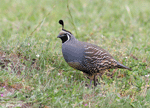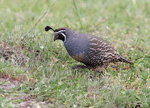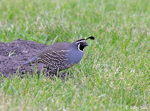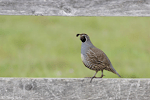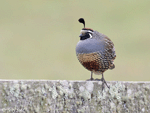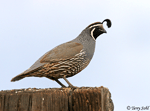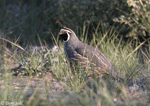| Length: 10 inches | Wingspan: 14 inches | Seasonality: Non-resident in South Dakota |
| ID Keys: Curved topknot, black chin and face, grayish upperparts and breast, scaly-looking belly, streaked sides | ||
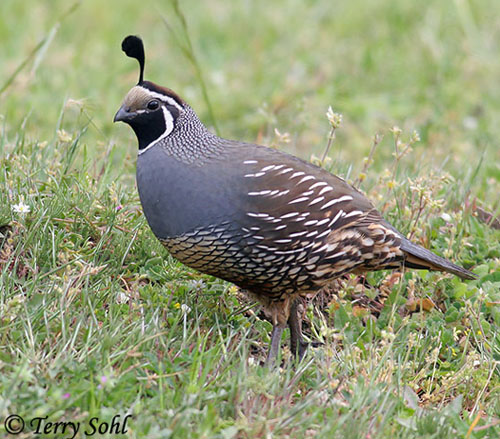 The
California Quail is a familiar site to many in its range in the western
U.S., with its distinctive top knot and plumage, and its adaptability to
living around humans. They are the state bird of California.
They live in small coveys, moving and feeding as a group. When an
individual bird is separated from the group, a familiar chi-CA-go
call is repeated until the bird can rejoin its group. Popular with
hunters, the species has even been introduced internationally as a gamebird
for hunting. They are very similar to the
Gambel's Quail in appearance, but the
ranges of the two species typically don't overlap.
The
California Quail is a familiar site to many in its range in the western
U.S., with its distinctive top knot and plumage, and its adaptability to
living around humans. They are the state bird of California.
They live in small coveys, moving and feeding as a group. When an
individual bird is separated from the group, a familiar chi-CA-go
call is repeated until the bird can rejoin its group. Popular with
hunters, the species has even been introduced internationally as a gamebird
for hunting. They are very similar to the
Gambel's Quail in appearance, but the
ranges of the two species typically don't overlap.
Habitat: They are often found in areas of chaparral mixed with open areas and riparian areas, but can also be found in a variety of other brushy or grassy habitats. They have also adapted to living in and around suburban areas.
Diet: Feeds mostly on seeds, leaves, and fresh buds. They will also eat fruits, berries, flowers, tubers, acorns, nuts, and insects. Depending on time of year and location, vegetation makes up between 60-90% of the diet.
Behavior: California Quail are very social birds, living in coveys that often number over 50 individual birds. They mostly forage on the ground, and typically in and around vegetative cover, although they will forage in open areas if cover is nearby. When disturbed, they will most often run away very quickly, but if pressed, will burst into short, low flights.
Nesting: The nest is typically a shallow depression in the dirt, placed next to a clump of vegetation or rock for protection, and lined with grasses. The nest can contain over a dozen eggs, especially when other females "dump" eggs into another female's nest. Both parents will help to raise the young.
Song: The call sounds like the word chi-CA-go, which is repeated in sequences from 3 to 10 times. Males and females have antiphonal calls, with males and females calling concurrently and complementing each other's calls in rhythm.
Migration: Considered a permanent resident throughout its range.
Interactive eBird map: Click to access an interactive eBird map of California Quail sightings
Similar Species: Gambel's Quail most similar. Also similar to Mountain Quail.
Feeders: California Quail will attend ground feeders for seed, or areas where seed is scattered on the ground.
Conservation Status: Populations of California Quail are generally stable, and the species is considered "least concern" by the IUCN. They have adapted well to a human presence, and have even maintained stable populations under quite heavy hunting pressure in parts of their range.
Further Information: 1) WhatBird - California Quail
2) California Quail - Audubon Guide
3) BirdWeb - California Quail
Photo Information: April 19th, 2007 - Point Reyes National Seashore, California - Terry Sohl
Additional Photos: Additional, higher-resolution California Quail photos can be found at the bottom of the page.
| Click below for a higher-resolution map |
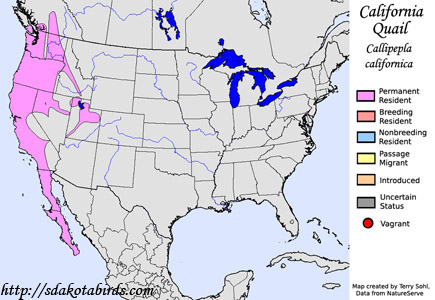 |
| South Dakota Status: Non-resident in South Dakota |
Additional California Quail Photos
